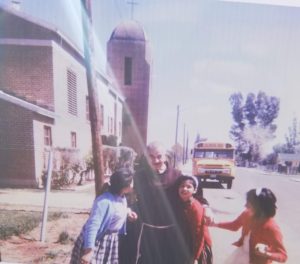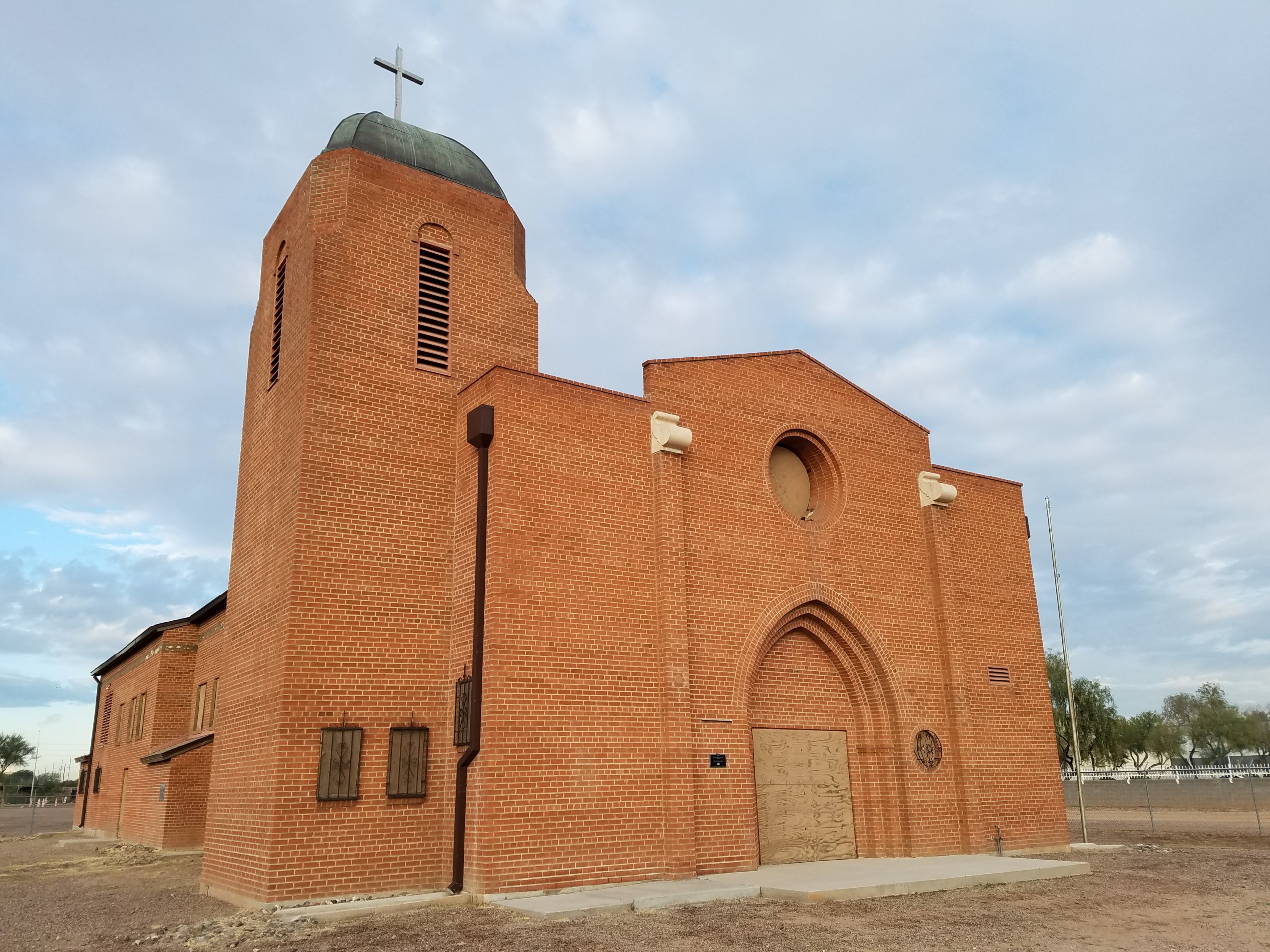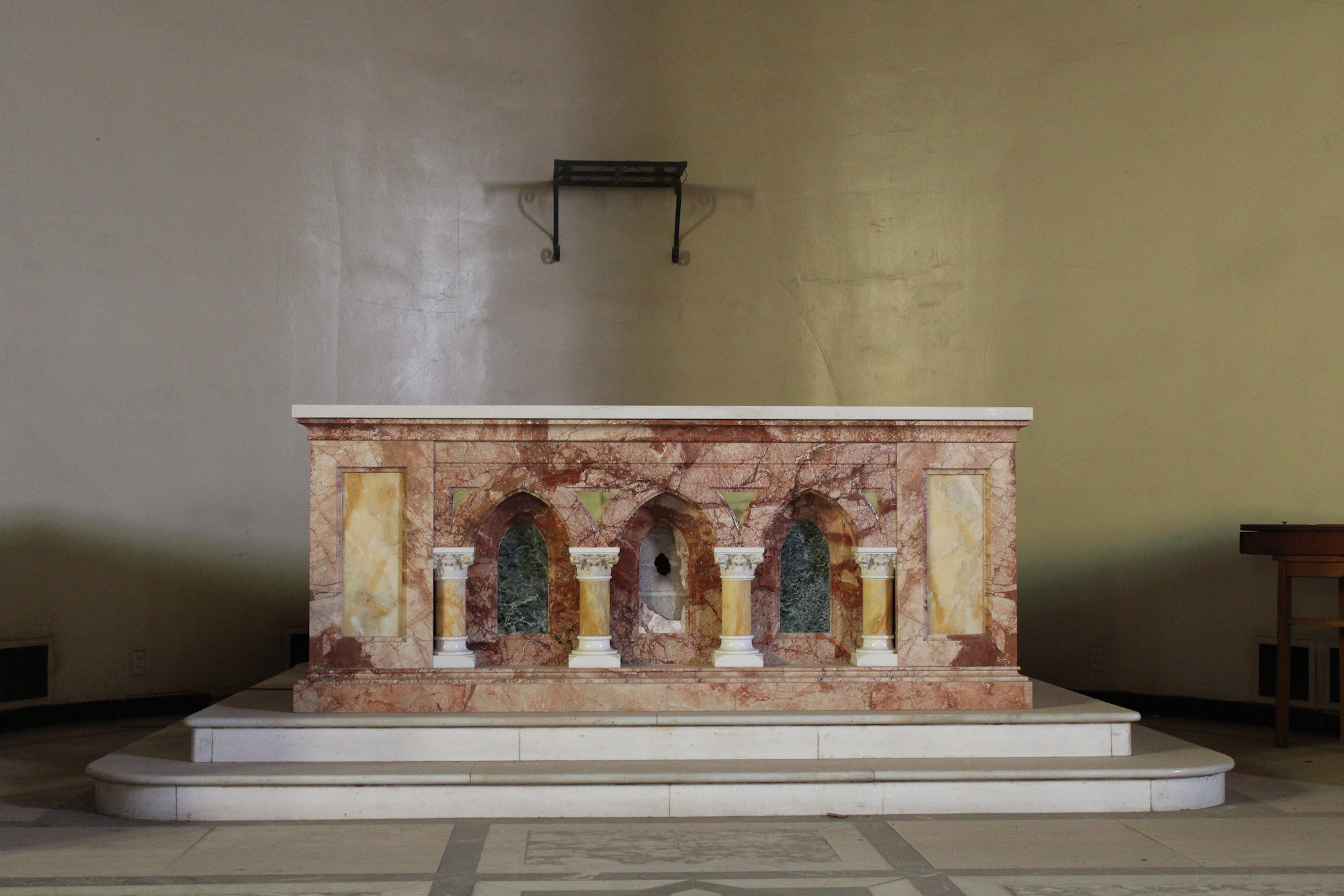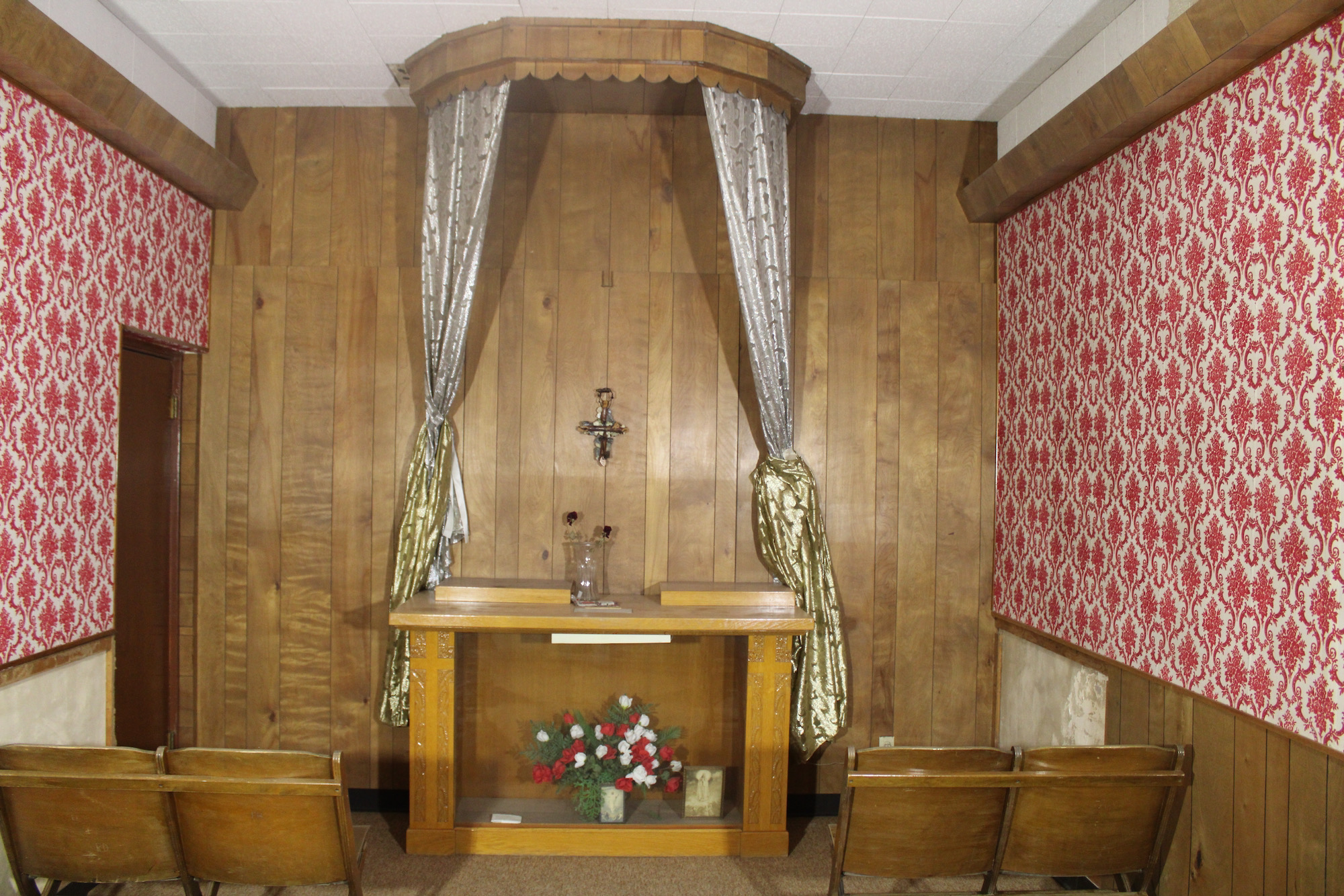Juan Gurule remembers his father, Estanislao, coming home tired after a day of joining a crew of fellow parishioners assisting Franciscan Father Albert Braun literally build their new church. Brick by brick, the entire community came together to erect that structure in 1954 as a “treasure” of what was once the Golden Gate Barrio.
“My dad worked for 35 years at Reynolds Aluminum, and when he went on strike, he had no income. He still worked at the church,” recalled Gurule, who was 6 at the time. “I can remember him talking about a unity, the euphoria of people having a purpose for laying that brick. Every brick had a purpose, and that purpose was to have their church to move from the ramada into God’s church. So, I remember him coming home, tired, a very happy person. And he reflected how there was a community building it.”

Everybody had a part to play. Women would help provide meals for the workers or would mix cement and lay bricks themselves. Teens and older children also helped mix cement and pushed the wheelbarrows, while others, like Gurule, were “looking more than helping.” Fr. Braun, already a legend in his own time as a survivor of a World War II concentration camp, challenged his new parishioners to “bring me a brick, and together we will build a church,” according to the church’s application to be on the National Historic Register. Parishioners purchased red bricks from the Phoenix Brickyard or, in some cases, brought bricks from their own homes, literally putting a part of their home in the church, said Gurule.
Today, that church sits on an empty dirt lot on the Northeast corner of 16th Street and Buckeye Road. The once vibrant Golden Gate Barrio was taken through eminent domain — the Diocese of Phoenix was forced to sell the property — to allow for the expansion of Phoenix Sky Harbor Airport.
“In the 1970s, the city declared it a slum — ‘detrimental to the health of the community’ — and had to be destroyed. At the same time, the airport is being expanded,” said pastor Fr. Paul Sullivan while walking through the historic church. “People don’t say it was a slum. They say it was their neighborhood, and I’ve seen no evidence of anything unhealthy.”
While the city of Phoenix has allowed an annual Christmas Mass to be celebrated at the property, the diocese formally took possession of Historic Sacred Heart in May of this year after a unanimous vote by the city council, allowing the church to be used as a church.
“The parishioners have always said that they wanted it to be used as a church. They longed for it to be used as a church,” Fr. Sullivan said. “So we are going to respect that and help them have their church back.”
All buildings, except for the historic church, were leveled. Gurule said he remembered when the city condemned his father’s property. While Estanislao contested the decision in court, the city bulldozed the house.
“That was the first time I’ve seen my dad cry. It was the first time and only time,” he said. “Can you imagine? Multiply that times 500-some families who were in that area, 6,000 people?”
The church was saved from demolition after the city received feedback from not only residents of the barrio, but other Catholics throughout the Valley.
“The city always knew that the people held it very dear, and there were certain organizations that kind of rallied around trying to save the church,” said Fr. Sullivan, referring to the Sacred Heart Braun Center and Chicanos por la Causa.

Restoration efforts
Now parishioners are working to refurbish the church with the same vigor as their forbearers did 67 years ago. While a new church was built in the mid 1980s at 12th Street on the other side of Buckeye, many still hope to worship regularly in the church where many received their sacraments of initiation.
“You can tell right away as soon as you enter into the community that a lot of the people, especially the elderly, really care about that church building because it is the place where they grew up, where they went to church, where they received their sacraments,” said seminarian Dcn. Marvin Soto, who is serving at Sacred Heart this year.
While some artwork has been restored, such as a statue of the Sacred Heart of Jesus and the “Cristo Muerto,” or entombed Christ that lays in the narthex, other items need to be replaced, such as the flooring and the doors — Fr. Sullivan had to physically lift the door from the ground when locking up. Because the church was built at a time when asbestos was used for construction, it will have to be professionally removed, he said.
This is where their family members are, this is where their friends are, this is where their relationship with the Lord has its history.
Sacred Heart began as a mission of St. Mark Parish, which was staffed by Franciscan priests at the time. The mission was established as a parish in the 1950s, with Fr. Braun as pastor. In addition to Golden Gate, it also served the Green Valley, Cuatro Milpas and El Campito barrios. Eventually, chapels were also built to serve the other barrios: Santa Rita, St. Mary Magdalene and San Juan Bautista, none of which are still in use.
That a parish established to serve a Hispanic barrio is “Sacred Heart” is fitting, says Dcn. Soto. In Hispanic culture — and Mexican culture in particular — devotion to the Sacred Heart of Jesus remains strong. He recalled exposing the Blessed Sacrament for Adoration and wanting to lead a traditional Mexican devotion where the presider says, “Sagrado Corazón de Jesús [Sacred Heart of Jesus],” and the congregation responds, “En vos confió [I trust in You].”
“I was kind of gambling there because I said, ‘I don’t know if they’re going to know what the response is,’” said Dcn. Soto. “It just came back to them immediately because it’s one of those rote things that you do. But rote or not, it’s something that is embedded for the culture, and it’s important for the people. So, I can see it being purposefully named as Sacred Heart to speak to the people personally.”
The historic church is connected to the Hispanic spirituality of South Phoenix, said Fr. Sullivan. Once it’s restored, he hopes to share the history of the community with visitors. It will be a historical chapel of the parish, he said, comparing it to the Old Adobe Mission that is a part of Our Lady of Perpetual Help Parish in Scottsdale.
“The history is somewhat similar. A humble generation — a hard-working generation — built it, and we want to respect that,” he said. “Maybe when we first open it, we will give tours, and we can explain the history and share some of the history that we know.”
Much of the original decorations in the historic church remain. The lights predate the church by 40 years — they were used in what is now the basement of St. Mary’s Basilica when that was used as its church. A Mosaic to the left of the sanctuary depicts the Holy Family’s Flight into Egypt, which, fittingly, parallels the story of the church.
“They were forced out by officials,” muses Fr. Sullivan.
Parishioners were forced to move after being displaced. Some moved down the street, while others moved elsewhere in the Valley, like Laveen or Maryvale, he said, but still commute to South Phoenix to attend Mass at Sacred Heart.
“This is still their homes, so they still come back to the parish,” said Fr. Sullivan. “This is where their family members are, this is where their friends are, this is where their relationship with the Lord has its history, and we will always allow them to stay in their spiritual home.”

‘Our community, our family’
At 40, Andrea Ochoa is among the last generation of parishioners to be baptized in the old church. Living in Tempe, she is also a part of the Sacred Heart diaspora that frequently commutes for Mass.
“Our family has always participated in the fiestas for Sacred Heart. I remember I was always with my grandparents, and it was always something involved in church. I still see some of the parishioners that sang with them when I go to the earlier Masses on Sunday,” she said. “I’m glad it’s back to the church and the diocese. In the future, our grandkids can be baptized there, and my husband and I can renew our wedding vows there.”
It’s a living life of over 6,000-plus people. That building lives, that’s why it was not demolished.
Her grandmother, Concepción Padilla — who is still alive at 80 — is one of the original members of the church. Ochoa’s family moved to North Phoenix in 1989 where they briefly attended Ss. Simon and Jude Cathedral. But today, most of her extended family goes to Mass at Sacred Heart Parish. Today, she and her husband and son split their time between St. Margaret Parish and commuting to South Phoenix.
“It’s our community there. It’s our family. That’s the church we’ve known all our lives, and everyone we see at church, they’re like family,” she said. “We’ve always been drawn back to Sacred Heart. It’s been our family church since as long as I can remember.”
Parishioner and Vietnam veteran Rey Rodriguez remembers moving to the barrio when he was 6. After the church was built and dedicated, a Catholic school and rectory were also built on the property. These, too, would be torn down when the city took over the neighborhood.
“Kids from all over the town, like people from 24th Street, would go to that church, go to that school. People from the river bottom, Green Valley,” recalled Rodriguez, a member of American Legion Post 41 that was established after World War II to serve Hispanic veterans. “It was a lot happening in those days. We would have a Jamaica, fiesta, and we’d close the main street down so we could make money for the church.”
Rodriguez still plays music at the parish church every Sunday. He and his wife, Lydia, regularly volunteer at the parish. Their oldest daughter, Michelle, was baptized in the historic church. He remembers the last regular Mass that was held there.
“It was a hard feeling. A lot of people didn’t want to see it go. But at the same time, people my age, they all moved on, they all moved out. The only time that they’d get together is on Christmas Day,” he said.

Gurule recalled sharing the news of Historic Sacred Heart returning to the diocese with a former parishioner who now lives in Black Canyon City. She responded to let her know when it would open so she could bring her 90-year old mother and 93-year-old father to visit the church.
“That spirit was never lost. They want to touch that building. They want to touch the block,” he said. “They want to be against the block because that building is not just a building, it’s a living life of over 6,000-plus people. That building lives, that’s why it was not demolished.”
Both he and his wife, Patricia, have hope that the community will be revitalized when the church opens back up. Patricia said that when the building is open, people will return.
“We’ve seen people gathering dirt from the area to put at the graveside of one of their relatives that have passed,” she said. “The spiritual life is tied to Sacred Heart — even though the parishioners have relocated throughout the whole state and the City of Phoenix. It is still there, and it’s embedded in you. I don’t think that will ever go away.”






